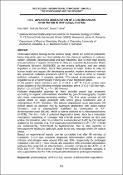Options
Advanced degradation of 4-chloroaniline from water in UV/TiO2/H2O2 system
Date issued
2013
Author(s)
Abstract
Chlorinated aniline belongs to the anilines family, which are common pollutants, being frequently used as intermediates for the chemical synthesis in polymer, rubber, pesticide, pharmaceutical and dye industries. Due to their high toxicity and persistence in aquatic environments, they are classified by European Water Framework Directive 2000/60/EC as the priority pollutants and are strictly regulated in EU countries. Since their presence in water bodies is risky for human health and aquatic life, developing powerful, modern treatment methods like advanced oxidation processes (AOP`s) are needed in order to assures pollution mitigation. If properly applied, TiO2-based photocatalysis can be regarded as an environmentally friendly and cheap treatment option. In the present study, solutions with (0.14-14.2) x 10-4 M 4-CLA content were photo-oxidized in the following working conditions: pH=4; [TiO2] = 50-500 mg/L; [H2O2] = (0.1-10)x10-3M; τirr = 5 – 180 minutes. Pollutant degradation pathway by three possible routes was proposed, according to organic intermediates identified by gas-chromatography coupled with mass spectrometry-screening method. The first route consists of OH radical attack on target pollutants with amino group substitution and 4- chlorophenol (4-CP) formation. The second degradation route represents OH radical attack on aromatic ring by hydrogen abstraction with aniline-radical formation, that is subsequently stabilized by dimerization to 4,4’- dichloroazobenzene (DCAB), which is further oxidized to 4-chloronitrobenzene (4-NCB). The third route of pollutant degradation takes place by a heterolytic mechanism consisting of hydrogen and chloride atoms release as HCl, and aniline (A) formation, which is oxidized to 4-aminophenol (4-AP) by OH radicals addition to the aromatic ring. The secondary intermediates (4-CP, 4-AP, 4-NCB) are subsequently hydroxilated to hydroquinone that is also oxidized to benzoquinone leading to carboxylic acids by its ring cleavage under OH radical attack. Based on experimental results can be concluded that after 90 minutes of irradiation, 4-CLA was complete degraded. Mineralization yields of organic chlorine and nitrogen were around 81% and 85%, respectively for prolonged irradiation (180 min.). These results are consistent with presented degradation pathway that proposed as intermediates, aromatic compound like 4-CP, A, 4- NCB and 4-AP. The presence of these intermediates in irradiated samples is also supported by 82.4% TOC removal yield obtained at prolonged irradiation.
Files
Loading...
Name
12. ADVANCED-DEGRADATION-OF-4-CHLOROANILINE.pdf
Size
135.67 KB
Format
Adobe PDF
Checksum
(MD5):8fa1c616989ef294da51730a035372cd